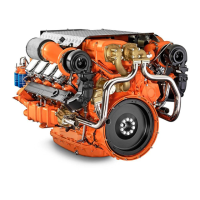
Do you have a question about the Scania DI16 and is the answer not in the manual?
| Engine Type | Diesel |
|---|---|
| Displacement | 16.4 liters |
| Fuel Type | Diesel |
| Cooling System | Liquid-cooled |
| Configuration | V8 |
| Bore | 130 mm |
| Stroke | 154 mm |
| Aspiration | Turbocharged |
| Turbocharger | Yes |
| Aftertreatment | Selective Catalytic Reduction (SCR) and Diesel Particulate Filter (DPF) |
| Fuel System | Common rail |
| Torque Output | 3500 Nm |
Key safety warnings for engine operation and maintenance.
Section for recording engine commissioning details and warranty information.
Scania's commitment to environmentally friendly engine development.
Information on engines approved for emissions certification standards.
Details on the four different operational power classes for Scania engines.
General safety guidelines to avoid injury and damage.
Safety measures to follow while the engine is running.
Safety precautions for handling fuels, oils, and chemicals.
Safety measures for engine upkeep and repairs.
Safety guidelines for electrical, fuel, cooling systems, and before starting.
Explanation of the engine type designation code and its components.
Description of the Engine Management System and its components.
Diagram showing the location of sensors for the EMS.
Procedures for reading and clearing EMS control unit fault codes.
Procedures for reading and clearing EMS coordinator fault codes.
Steps for the initial engine start and checks.
Pre-operation checks to ensure engine readiness.
Step-by-step guide on how to start the engine safely.
Information on operating the engine at different speeds and conditions.
Procedures for starting the engine in cold weather conditions.
Normal and alarm levels for coolant temperature and oil pressure.
Correct procedures for shutting down the engine.
Post-operation checks to perform after stopping the engine.
Overview of maintenance tasks based on operating hours and time.
Detailed schedule for lubrication, cooling, air, fuel, electrical, and misc. maintenance.
Recommended oil grades, viscosities, and oil analysis for engine health.
Steps for checking oil level and performing an oil change.
Procedures for cleaning the centrifugal oil cleaner.
Steps for renewing the engine oil filter.
Procedures for checking and topping up engine coolant level.
Checks for sacrificial anodes and sea water pump impeller.
Checking coolant appearance, glycol content, and corrosion inhibitor.
Procedures for draining and refilling the engine coolant.
Detailed steps for cleaning the engine heat exchanger unit.
Procedures for dismantling, cleaning, and reassembling the charge air cooler.
Checking the vacuum indicator for air filter condition.
Procedures for cleaning or renewing the air filter element.
Checking fuel level and draining the water separating filter.
Steps for renewing the main fuel filter.
Procedures for bleeding the fuel system after filter changes or dry runs.
Procedures for checking battery electrolyte level, charge, and cleaning.
Steps for disconnecting and reconnecting the battery.
Checking the function of the optional coolant level monitor.
Checking the condition and tension of the drive belt.
Daily checks for oil, coolant, fuel, and exhaust leaks.
Checking and adjusting valve clearances.
Procedure for adjusting the rocker arm on PDE31 unit injectors.
Procedure for adjusting the rocker arm on PDE32 unit injectors.
Steps for preparing the engine for short and long-term storage.
Using special coolant and fuel for engine preservation.
Using preservative oil and general preparations for storage.
Storing the engine and procedures for taking it back into operation.
Key engine dimensions, displacement, and performance specifications.
Oil pressure specifications and crankcase pressure.
Data for fuel, cooling, and electrical systems.
Requirements and standards for diesel fuel quality.
Formal declaration of engine compliance with EU directives for recreational craft.
